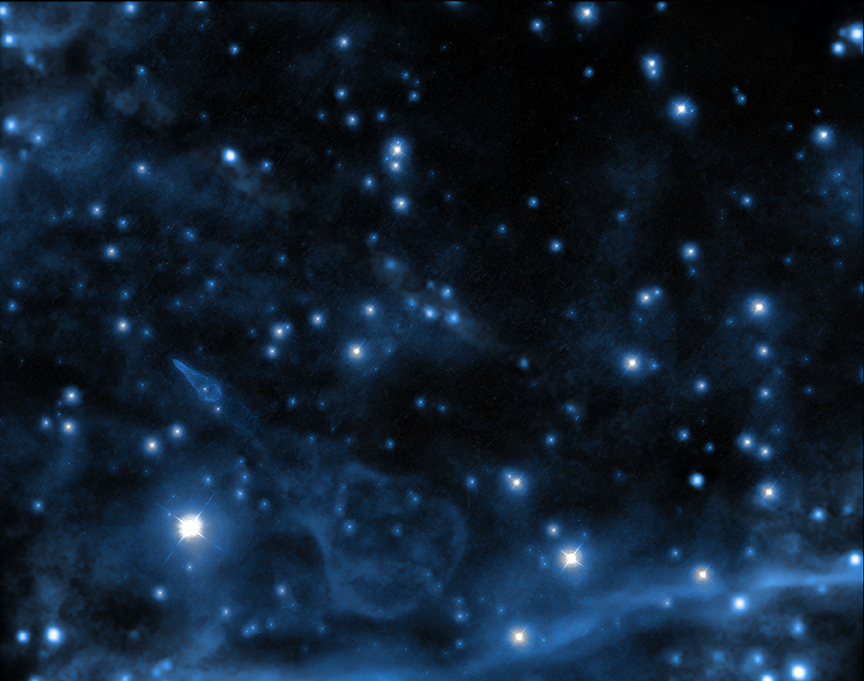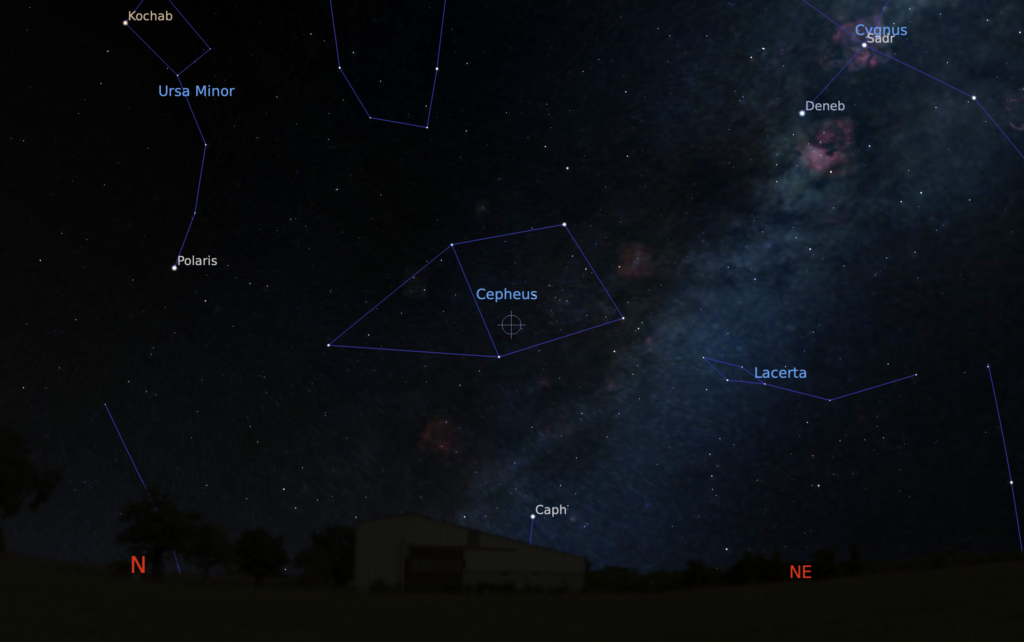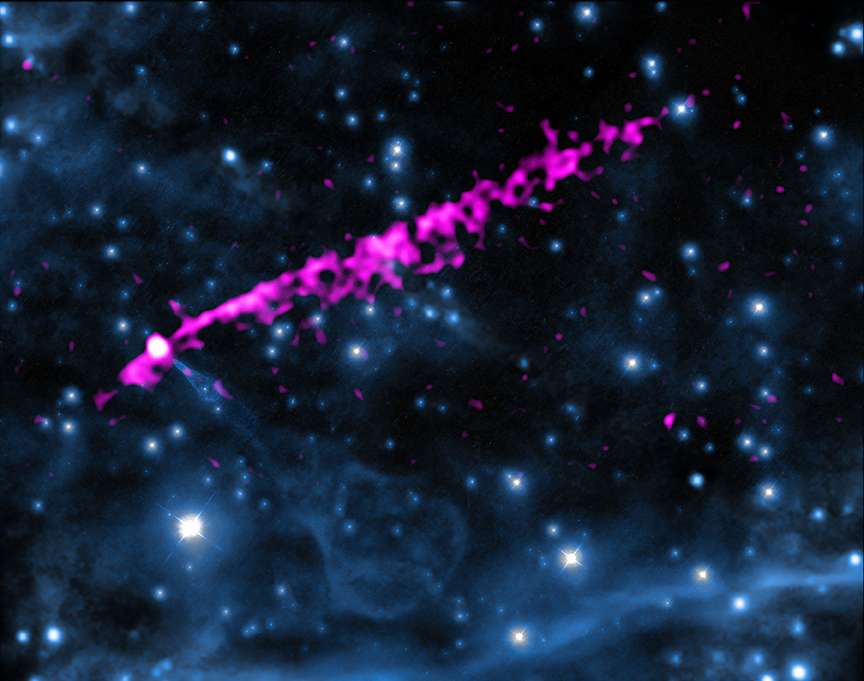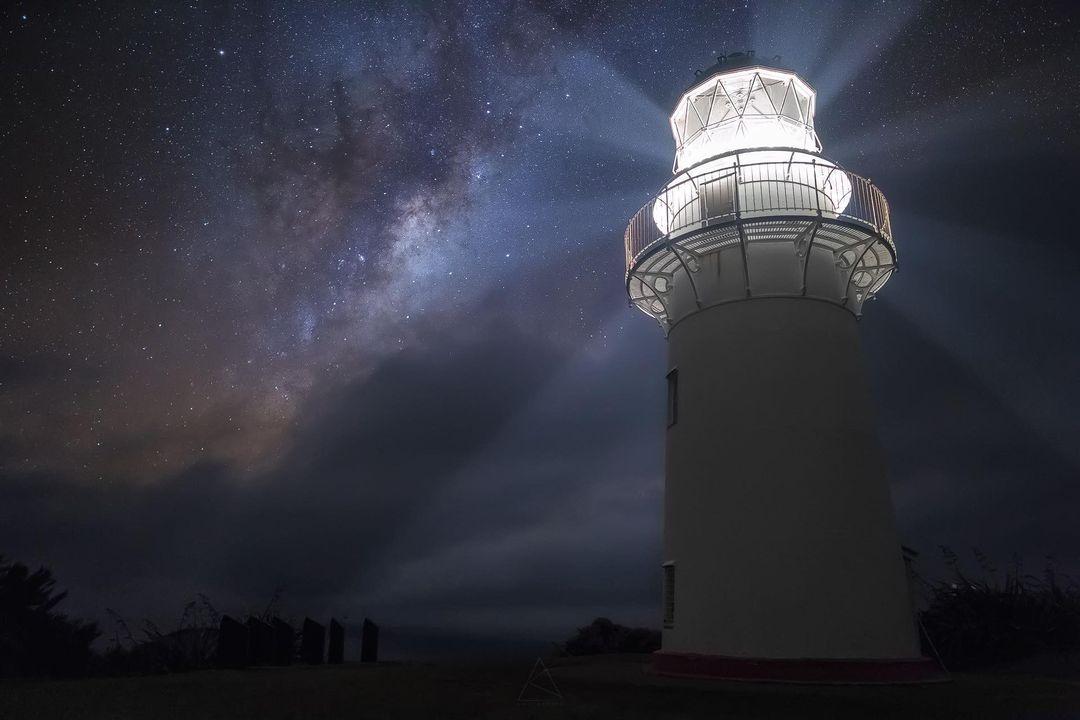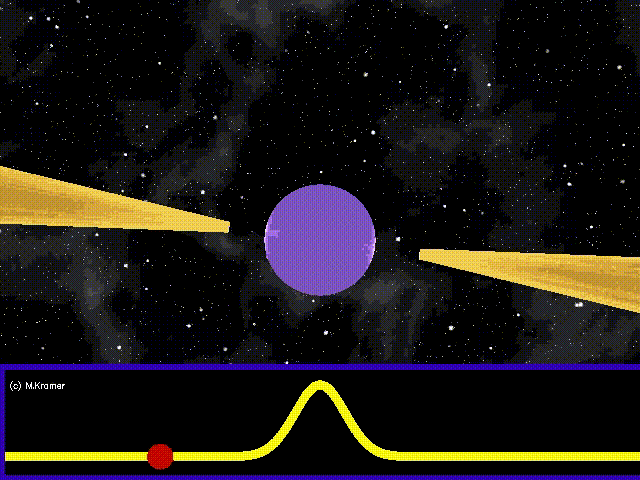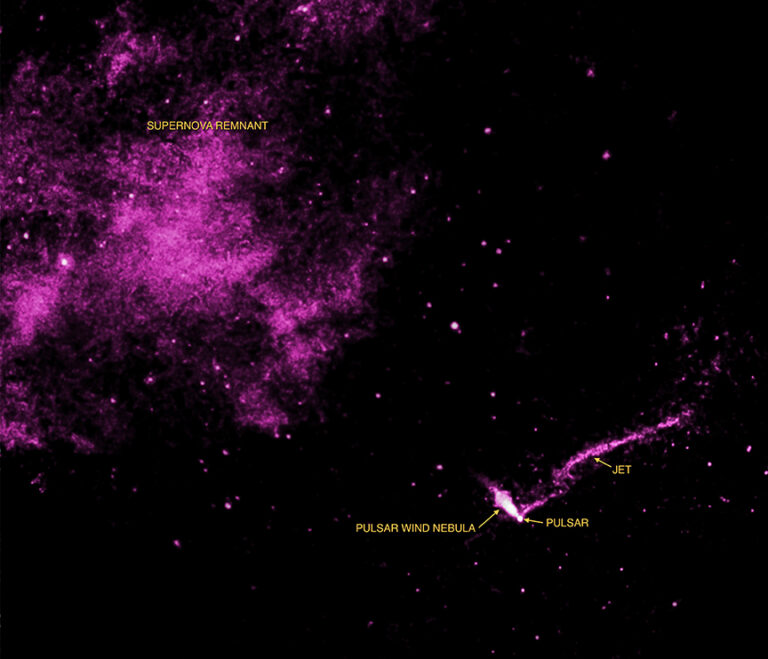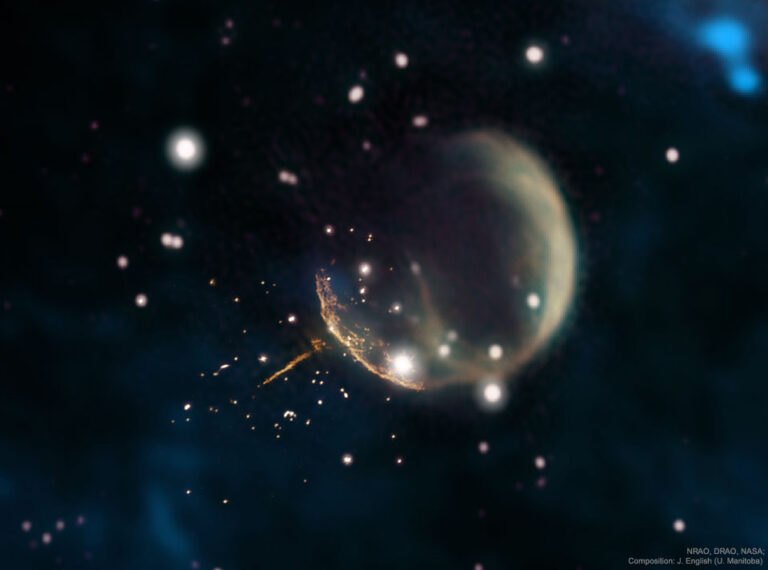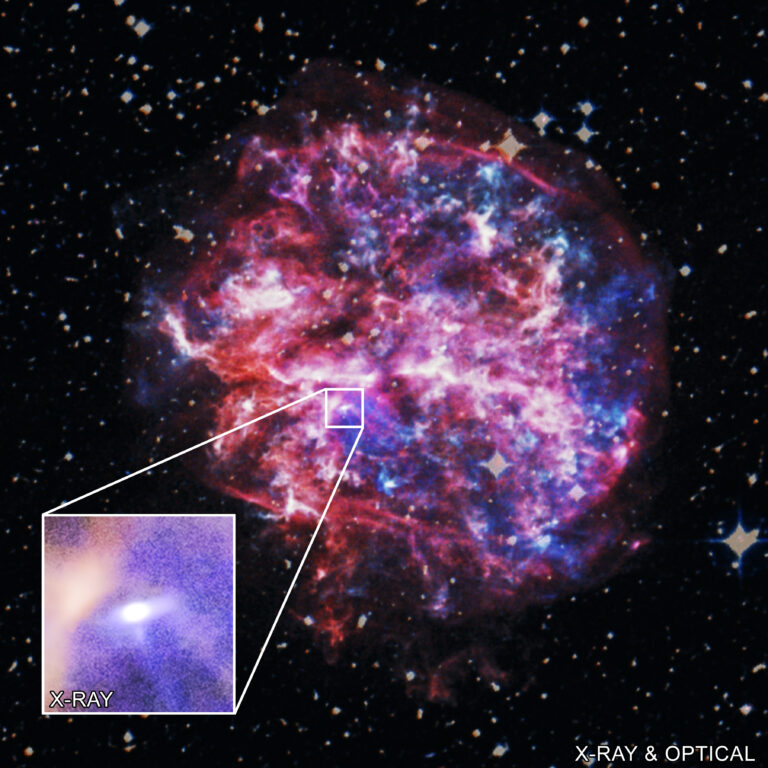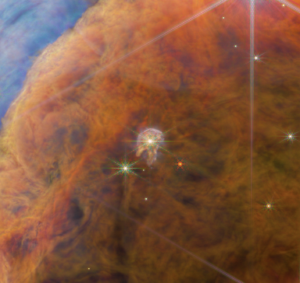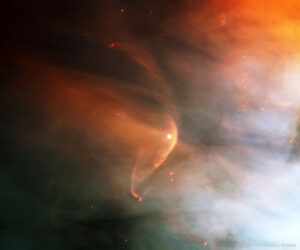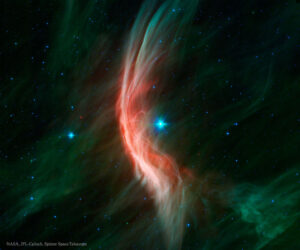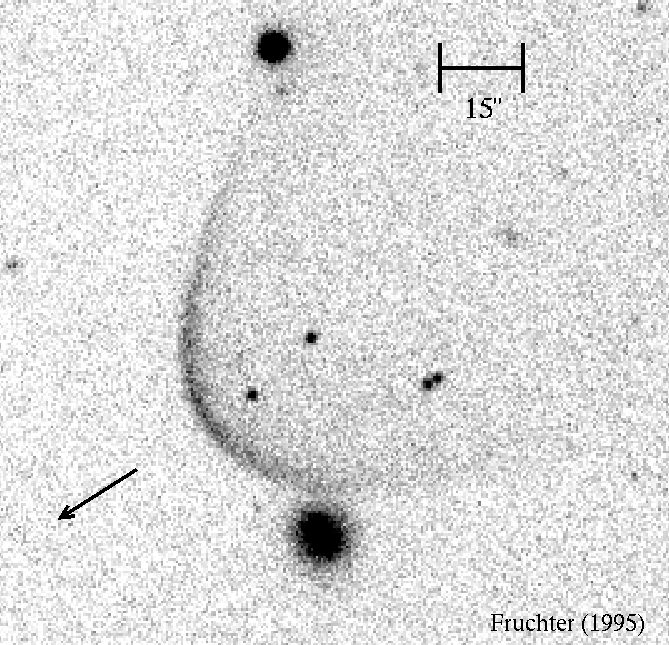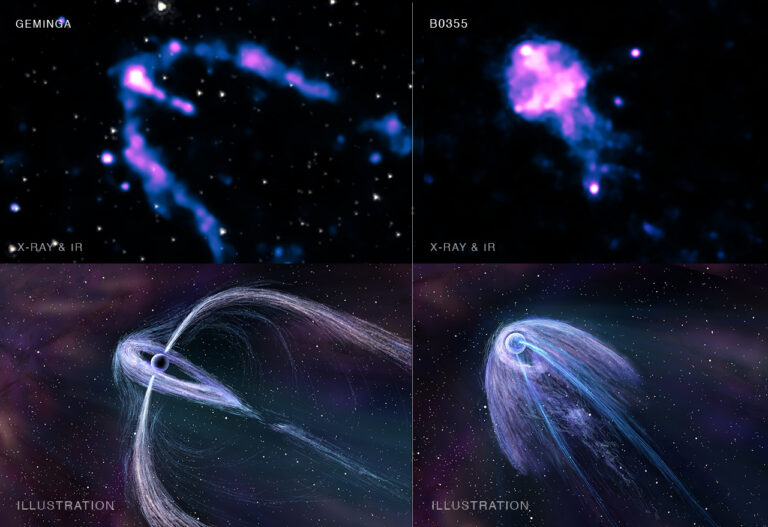Sky is a Neighbourhood
The Guitar Nebula in Optical wavelength. Credit: NASA/STScI & Palomar Observatory 5-m Hale Telescope. Description
What are you looking at?
The nebulous structure in the image is commonly called the Guitar Nebula as it resembles a shape of a guitar. The shape looks like a Dreadnaught guitar with a shorter neck and a distinctly visible headstock. The structure is a result of a rapidly moving star and its interaction with the surrounding interstellar medium. The star is a Pulsar named PSR B2224+65. In fact, the star is moving so fast that it may escape our galaxy.
Where is it?
The Guitar Nebula is associated with the Pulsar PSR B2224+65 and the name actually tells us about the Right Ascension and Declination of the source. RA and Dec are coordinates used to locate objects in the sky. So the RA is 22h 24m and Dec is +65° which is somewhere in the constellation of Cepheus and close to Polaris.
The distance to B2224+65 (let’s call it B22) is estimated to be 0.83 +0.17|-0.10 kpc using parallax. The distance is ~2700 light years which is almost 1/10th of the distance to the centre of the Milky Way (refer a). The surface brightness of even the brightest parts of Guitar Nebula is low for easy observation and thus it was only discovered in 1992.
The star has a proper motion of 194.1±0.2 milliarcseconds per year. Proper motion is a measure of the angular speed of the object in RA-Dec or similar coordinates. Knowing the distance to the star enables us to calculate the relative speed it is moving with. The results from paper (a) suggest a speed of ~765 kmps (0.0025 c) The speed is very high for a star. To make sense, the star is moving so fast that it will pass from one point on Earth to the diametrically opposite one in less than 17 seconds and will cover the Earth-Moon distance in less than 9 minutes. The fastest speed recorded for a manmade object is of the Parkers Space Solar probe which is supposed to reach a speed of 194 kmps. This is possible due to the spacecraft going so close to the Sun, similar to a ball falling and accelerating towards Earth. The velocity of the pulsar lies close to the plane of sky or perpendicular to our line of sight (refer b).
The Guitar Nebula in Optical wavelength. Credit: NASA/STScI & Palomar Observatory 5-m Hale Telescope. Description
The image in Optical wavelengths comes from Palomar Observatory’s 5 metre Hale Telescope and NASA/STScI. The Nebula predominantly radiates at Hα wavelength which corresponds to radiation due to the transitions between the 3rd and 2nd orbit of the Hydrogen atom. The wavelength is 656nm belonging to the red colour on the spectrum. The nebula is a result of a Bow shock created by the Pulsar speeding through the Interstellar medium. The Pulsar has been speeding for almost 300 years leaving a trail of the observed Nebulosity to evolve. In the region of the guitar body, the formation of inflating bubbles might be due to the star passing through the medium of non-uniform density or changes in the Pulsar wind over the journey” (refer c).
The guitar has a distinctly visible headstock which has higher surface brightness compared to the trailing nebula, this structure further enhances its guitar-like appearance. According to paper (d), bright regions of the headstock which are perpendicular to the motion of the star have moved outwards, as shown in the linked figure from paper (d) as well as below. They also suggest that some 70 years ago the Pulsar broke through a dense region in ISM which is behind the head of the guitar. The shock in this dense region at the end of the headstock prevents the flow of relativistic winds from the Pulsar towards the rest of the Guitar body. This explains the brightening of the headstock and prevents the wind from powering the rest of the Guitar body, thus producing the dim, elongated and narrow ‘neck’ of the Guitar.
The figure shows the cropped view of the headstock region from Hubble Telescope’s Hα images (1994-2020). Credits: Martijn de Vries et al 2022 ApJ 939 70
These newly formed regions may evolve in the future to form other inflating bubbles in the nebulosity (refer d).
An image combining both Optical and X-ray data in the Guitar Nebula region. Jet-like features are visible in X-rays. Credit: X-ray: NASA/CXC/UMass/S.Johnson et al, Optical: NASA/STScI & Palomar Observatory 5-m Hale Telescope. Source
Now to the best part, The observation of the region in X-rays by Chandra telescope reveals jets extending out from the Guitar headstock just like the guitars with flamethrowers or firecrackers which are used in the live performances by many rock bands. (Here it’s on a Dreadnaught guitar, a rare sighting :P)
The star B22 sits at the tip of the headstock which can be confirmed in the X-ray image. The hot spot seen at the tip of the headstock is not necessarily the bare Pulsar surface but the synchrotron radiation from the shocked nebula around it (refer e). Synchrotron radiation is observed from relativistic or very fastly moving charged particles when they are accelerated perpendicular to their direction of motion, in this case, these charged particles are spiralling about the magnetic field lines. The path of such particles about these magnetic field lines looks locally helical.
The upper jet originating from the Pulsar is aligned at roughly 115° with the direction of the proper motion of this Pulsar. Figure (7) from paper (b) provides a wider field of view to get an idea of the extension of the jet-like filament away from the Nebula. According to paper (f) this jet-like X-ray feature arises due to the leakage of high-energy electrons accelerated at the bow shock region which is formed around the Pulsar. They continue to travel along magnetic fields in the ISM. The lower jet structure is comparatively shorter than the upper which paper (f) suggests is due to asymmetries in interaction with ISM’s magnetic field.
Pulsar Kicks
B22 is a Pulsar and it belongs to a general class of stars called ‘The Neutron stars’. Neutron stars are very dense and are remnants from core-collapse supernovae of stars a lot more massive than the sun. They are mostly composed of Neutrons hence Neutron stars. And Pulsars are a type of Neutron star which show Pulsing behaviour understood as beams of radiation coming from the star which behave similarly to the beams of a lighthouse. It goes on and off due to its rotation as we view it.
East Cape Lighthouse, NZ looks stunning with Milky Way on a cloudy night. A queen from a night chess set? Credits: @exploringnightsky | Amit Kamble (His unique Astrophotography style has always been fascinating to look at)
A small amount of population of neutron stars has been observed to be speeding with high velocities. B22 has an estimated velocity of ~765 kmps in the plane of the sky. Another example is the pulsar IGR J1104-6103 which is moving at a speed of more than 1000 km/s (refer g). A trailing nebula called the lighthouse nebula is associated with this Pulsar and the associated jets are the longest yet known for an object in the Milky Way. In the X-ray image below, the star can be seen trailing away from a nebulosity which is supposed to be the remnant debris from its supernova. An asymmetry in the jets is also visible quite similar to B22, which paper (f) suggests is due to asymmetries in interaction with ISM’s magnetic field.
These are some more eye candies
In the above image, the star PSR J0002+6216 seems to be speeding away from the remnant nebulosity of its supernova and a similar behaviour has been observed for other such stars suggesting they acquired this velocity during or after the supernova. This phenomenon of speeding neutron stars i.e. they having speeds much greater than their progenitor stars is supposed to be due to kicks they acquire during the supernovae. This in itself is an interesting problem.
The kick acquired during a supernova can be due to an asymmetry in the event. During a supernova, the star’s outer layer bounces off the interior, resulting in this dense core called a neutron star. If there is mechanical or convection-related instability inside the star before the supernova this can affect the energetic events inside the star during the process of a supernova. This can push the remnant core (which are neutron stars) in a particular direction. This can result in imparting the velocities at which we see them moving.
One solution to the problem goes to the very fundamental properties observed in our Universe and it comes from Neutrinos. Neutrinos are particles that constitute matter just like electrons and protons do. Particles have handedness (simply right-handed and left-handed) which is related to the direction of their spin axis. All these matter particles have both right-handed and left-handed versions of their matter particle and antimatter particle. But experimentally we have only observed left-handed neutrinos and right-handed antineutrinos (refer h). The other counterparts are thought to be interacting only gravitationally and are also supposed to be massive. These are called sterile neutrinos. During supernovae both neutrinos and sterile neutrinos are produced but due to this asymmetry in their properties and choice of interaction, they can impart kicks to the Pulsars.
One more suggestion exploiting this asymmetry has to do with neutrinos in strong magnetic fields. In strong magnetic fields, the direction in which the neutrino is scattered off the nucleus is biased in some direction (refer i). This on average can lead to neutrino drift to be aligned in some way and lead to asymmetry in supernova.
Another solution is that the kick is post-natal or after the supernova phenomena. There is an asymmetry in the emission of radiation and it is the radiation pressure that accelerates the Pulsar. This can be verified based on velocity and correlation of its spin-down rate as it is the rotational energy that feeds the acceleration engine. Also, the correlation of spin and/or magnetic moment can give insight.
Bow Shocks
Like a boat producing waves on a still water surface or a jet speeding at supersonic speed, the fastly moving Astronomical objects produce bow shocks as they pass through the surrounding medium. The nature of the bow shock depends on the relative velocity of the object and the medium. In the case of B22 the bow shock is produced due to the interaction of its relativistic Pulsar winds and surrounding interstellar medium. The winds bump at high velocity in the ISM. The magnetic fields are also involved in characterising the Bow shocks for these objects.
Bow shocks are common phenomena observed around different types of objects “with magnetic fields or high relative velocity in the medium.” For example, the interaction of Earth’s magnetic field and surrounding plasma also creates some type of bow shock which is due to the slowing down of the plasma as it approaches the Earth’s magnetosphere.
These are some eye candies showing Bowshock formation in different scenarios.
These are examples of bow shocks observed in different type of stars each with somewhat different mechanism
Bow shocks related with Pulsars
It is fascinating how phenomena in objects as big as stars can be imagined to be a result of the Universe’s fundamental properties, like neutrinos which still stand as mysteries. Studying them all helps us uncover more about nature. A quote from Feynman sums it pretty well.
“Nature uses only the longest threads to weave her patterns, so each small piece of her fabric reveals the organization of the entire tapestry.”
Richard P. Feynman
Mentioned References
Discovery Paper – https://ui.adsabs.harvard.edu/abs/1992AAS…181.6003L/abstract
(a) https://ui.adsabs.harvard.edu/abs/2019ApJ…875..100D/abstract
(b) https://ui.adsabs.harvard.edu/abs/2022ApJ…939…70D/abstract
(d) https://ui.adsabs.harvard.edu/abs/2004ApJ…600L..51C/abstract
(e) https://ui.adsabs.harvard.edu/abs/2003IAUS..214..135W/abstract
(f) https://ui.adsabs.harvard.edu/abs/2019MNRAS.485.2041B/abstract
(g) https://www.nasa.gov/mission_pages/chandra/multimedia/runaway-pulsar.html
Articles about Guitar Nebula
- http://hosting.astro.cornell.edu/~shami/guitar/
- https://briankoberlein.com/blog/kick-me
- (c) https://www.seramarkoff.com/2020/05/the-runners-trails-the-characteristic-features-of-fast-moving-x-ray-binaries-or-bow-shock-pulsars/
- http://palomarskies.blogspot.com/2009/07/guitar-hero.html
Other Articles and Readings
- https://articles.adsabs.harvard.edu//full/2004MSAIS…5..195P/0000195.000.html
- https://iopscience.iop.org/article/10.3847/2515-5172/abd854
- (i) https://en.wikipedia.org/wiki/Pulsar_kick
- https://en.wikipedia.org/wiki/Bow_shock
- (h) https://neutrinos.fnal.gov/mysteries/handedness/
- https://www.nasa.gov/feature/goddard/2019/nasa-s-fermi-satellite-clocks-cannonball-pulsar-speeding-through-space
- https://www.nasa.gov/mission_pages/chandra/images/nasa-s-chandra-catches-pulsar-in-x-ray-speed-trap.html
Image Credits and Articles
(F2) https://public.nrao.edu/news/cannonball-pulsar/
(F3) https://chandra.harvard.edu/photo/2022/g292/
(F4) https://www.nasa.gov/feature/goddard/2023/webb-makes-first-detection-of-crucial-carbon-molecule
(F5) https://apod.nasa.gov/apod/ap031115.html
(F6) https://www.spitzer.caltech.edu/image/sig12-014-massive-star-makes-waves
(F7) https://www.stsci.edu/~fruchter/nebula/
(F8) https://chandra.harvard.edu/photo/2017/geminga/
